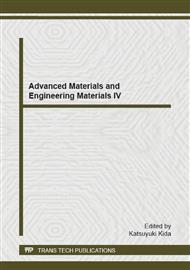[1]
H. W. Shin, H. S. Lee, and S. B. Jung, Analysis on thermal resistance of LED module with various thermal vias, in Physical and Failure Analysis of Integrated Circuits (IPFA), 2011 18th IEEE International Symposium on the, 2011, pp.1-4.
DOI: 10.1109/ipfa.2011.5992760
Google Scholar
[2]
A. Poppe, B. Siegal, and G. Farkas, Issues of thermal testing of AC LEDs, in Semiconductor Thermal Measurement and Management Symposium (SEMI-THERM), 2011 27th Annual IEEE, 2011, pp.297-303.
DOI: 10.1109/stherm.2011.5767214
Google Scholar
[3]
H. Jianzheng, Y. Lianqiao, and S. Moo Whan, Thermal and Mechanical Analysis of High-Power LEDs With Ceramic Packages, Device and Materials Reliability, IEEE Transactions on, vol. 8, pp.297-303, (2008).
DOI: 10.1109/tdmr.2008.920298
Google Scholar
[4]
Y. J. Heo, H. T. Kim, K. J. Kim, S. Nahm, Y. J. Yoon, and J. Kim, Enhanced heat transfer by room temperature deposition of AlN film on aluminum for a light emitting diode package, Applied Thermal Engineering, vol. 50, pp.799-804, (2013).
DOI: 10.1016/j.applthermaleng.2012.07.024
Google Scholar
[5]
B.H. Liou, C.M. Chen, R. -H. Horng, Y.C. Chiang, and D. -S. Wuu, Improvement of thermal management of high-power GaN-based light-emitting diodes, Microelectronics Reliability, vol. 52, pp.861-865, (2012).
DOI: 10.1016/j.microrel.2011.04.002
Google Scholar
[6]
H. Fengze, Y. Daoguo, G. Q. Zhang, and L. Dongjing, Research on heat dissipation of high heat flux multi-chip GaN-based white LED lamp, in Electronic Packaging Technology and High Density Packaging (ICEPT-HDP), 2011 12th International Conference on, 2011, pp.1-5.
DOI: 10.1109/icept.2011.6067020
Google Scholar
[7]
R. Vairavan, Z. Sauli, V. Retnasamy, N. Khalid, K. Anwar, and N. Abdullah, Natural Heat Convection Analysis on Cylindrical Al Slug of LED, Applied Mechanics and Materials, vol. 487, pp.536-539, (2014).
DOI: 10.4028/www.scientific.net/amm.487.536
Google Scholar
[8]
R. Vairavan, V. Retnasamy, and Z. Sauli, CuDia Slug Size Variation Analysis on Heat Dissipation of High Power LED, Applied Mechanics and Materials, vol. 487, pp.33-36, (2014).
DOI: 10.4028/www.scientific.net/amm.487.33
Google Scholar
[9]
R. Vairavan, Z. Sauli, and V. Retnasamy, Operating Temperature Analysis of LED with Cylindrical Cu Slug, Applied Mechanics and Materials, vol. 487, pp.145-148, (2014).
DOI: 10.4028/www.scientific.net/amm.487.145
Google Scholar
[10]
M.H. Chang, D. Das, P. V. Varde, and M. Pecht, Light emitting diodes reliability review, Microelectronics Reliability, vol. 52, pp.762-782, (2012).
DOI: 10.1016/j.microrel.2011.07.063
Google Scholar


